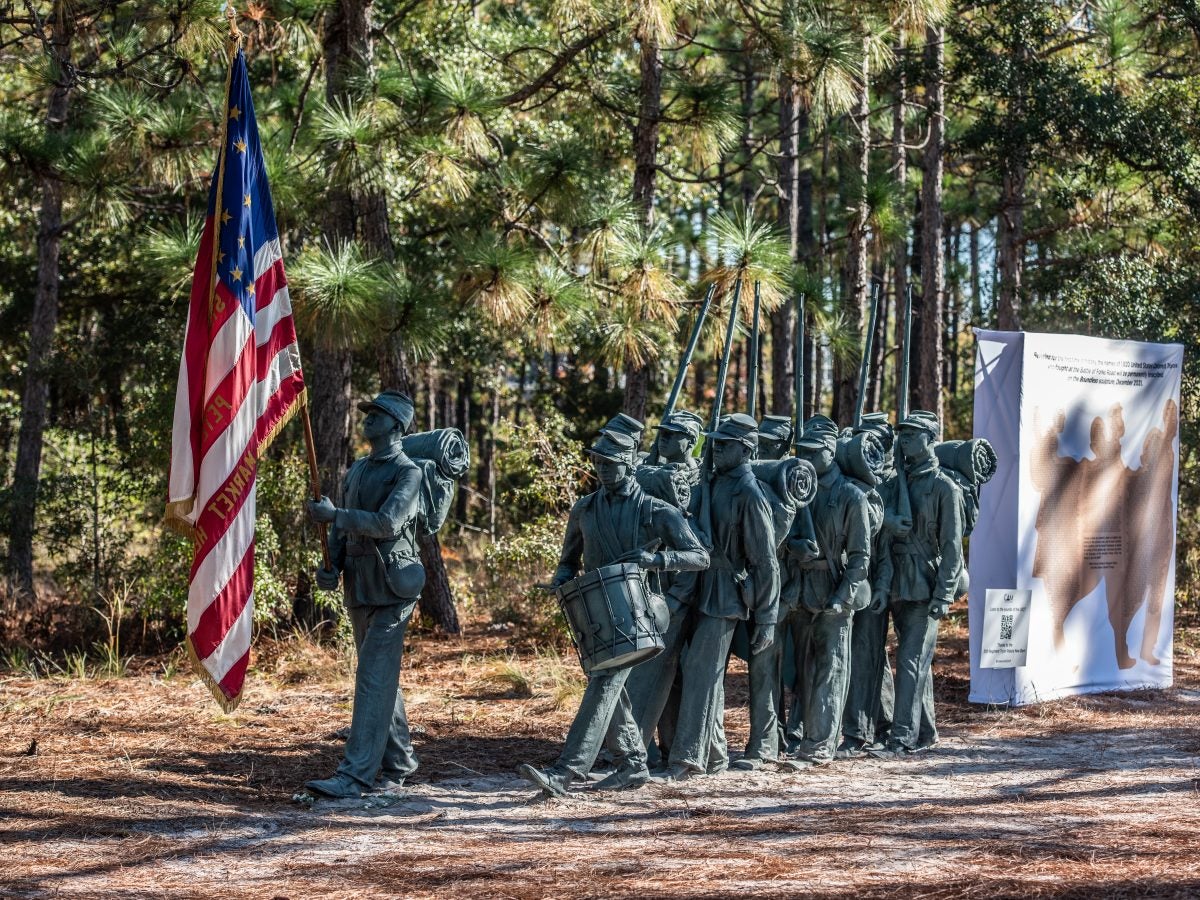
As Civil War monuments honoring Confederate soldiers are being taken down across the nation, the Cameron Art Museum (CAM) in Wilmington, NC decided to go the opposite route and erect a monument honoring the Black soldiers who fought in the Union Army during the war.
In November, CAM unveiled “Boundless,” a bronze sculpture featuring life-size casts of 11 African-American men from the United States Colored Troops (USCT), the first in the state to honor these Black Civil War fighters.
After being commissioned for this project, artist Stephen Hayes, who was born and raised in North Carolina, started researching the Battle of Forks Road. The sculpture, which is located on the grounds of CAM, is also the actual site where the USCT soldiers once led the Union advance in the battle.
Even though the Battle of Forks Road may have escaped mainstream knowledge, it was a critical turning point in the Northern victory against the South. Wilmington was the last key seaport that remained open and also served as a crucial link in the supply chain for Robert E. Lee’s Virginia army in the South. It is important to note that over 50 percent of the Union casualties from this Wilmington drive were USCT soldiers, most of whom perished at the Battle of Forks Road.
As Hayes told Essence, “[When I] was contacted by CAM, and they told me about the grounds the land was on…I thought about how can I bring that to today, and still relate to today, so that’s why I decided to make castings of the descendants and the reenactors, to talk about the continuous struggle that we’re going through today to be equal…Being from North Carolina and creating this monument was great. I want to change that narrative, open these doors and shed light or create conversations for people, African-American people, people of color, anybody because these are conversations that need to be held and people are afraid to say things.”
Hayes said he ultimately “want[s] to change the narrative about how somebody views somebody who looks like me or create a conversation for people. That’s what I want to do with my work. My work deals with capitalism, consumerism, brainwashing, and the idea of a Black body, and how the Black body is being seen today. I want to bring these things to life.”
The concept he chose for “Boundless” “included a series of life-size bronze statues depicting the three ranks of USCT soldiers, along with a color guard and a drummer, marching toward the Confederate fortifications” to honor those who had previously been unrecognized despite being integral in Northern victory and the abolition of slavery.
Hayes received the 1858 Prize for Contemporary Southern Art last year in 2020, teaches at Duke University, and is world-renowned for his figurative pieces. He told Essence that hopes this sculpture can serve as a source of healing and also discussed the personal nature of this work for him, “As a Black man in America, you see the imagery of a Black person in chains, being whipped, begging, kneeling and helpless. This project is important to me because, as a creator, I get to change that narrative — by giving Black soldiers a sense of honor and pride.”
The importance of the Battle of Forks Road cannot be overstated, and as emeritus professor of history at the University of North Carolina-Wilmington, Chris Fonvielle pointed out, “less than two months after this battle and the city’s subsequent capitulation, Lee was forced to surrender at Appomattox.”
Fonvielle further commented, “In the end, the right side won, and African Americans contributed mightily to that effort…[and] Wilmington is coming to grips with how badly Blacks were treated for 150 years.”
This story of the USCT soldiers and the Battle of Forks Road and the accompanying unveiling of the “Boundless” sculpture are incredibly well-timed given the current racial climate, as our nation is forced to reckon and come to grips with racism.
In addition to the monument, CAM is also creating a curriculum that expounds on the stories of USCT soldiers and Civil War aftershocks in southeastern North Carolina as well as exploring the historical overtones, present moments, and ramifications for the future in the fight for equality.
